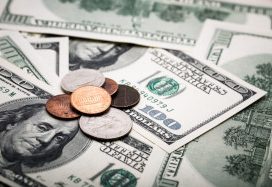Home / Forex news / US Dollar Falls amid Risk Appetite, Positive Data Doesn’t Help

The US dollar fell along with other safe-haven currencies, like the Swiss franc and the Japanese yen, as the market sentiment favored riskier currencies linked to growth. In fact, the Swissie was the only currency that fared worse than the greenback as the dollar fell even versus the yen, though it has been trying to rebound versus the euro too at the time of writing. Domestic macroeconomic data was favorable to the US currency but had seemingly little impact on the market.
Markit released flash readings for manufacturing and services PMIs in February. The manufacturing Purchasing Managers’ Index fell from 59.2 in January to 58.5 this month, in line with market expectations. On the other hand, the services PMI rose from 58.3 to 58.9, surprising experts who were counting on a drop to 57.9. Both indicators remained far above the neutral 50.0 level, meaning that the industries have been expanding at a significant pace. Indeed, Chris Williamson, Chief Business Economist at IHS Markit, sounded optimistic in his comments:
Despite headwinds of COVID-19, extreme weather and record supply chain delays, US businesses reported the fastest output growth for almost six years in February. The data add to signs that the economy is enjoying a strong opening quarter to 2021, buoyed by additional stimulus and the partial reopening of the economy as virus related restrictions were eased on average across the country.
Yet he also mentioned that there were reasons for some concern:
Business sentiment remains buoyant, boosted by hopes of further stimulus and the vaccine roll out, but itâs disappointing to see this not yet translate into stronger jobs growth. Many service sector firms in particular remain reluctant to hire, cautious about adding to overheads. A concern is that firms costs have surged higher, driving selling prices for goods and services up at a survey record pace and hinting at a further increase in inflation.
Existing home sales provided another positive surprise, rising to a seasonally adjusted annual rate of 6.69 million in January from 6.65 million in the previous month. That is instead of falling to 6.59 million as analysts had predicted. Lawrence Yun, a chief economist at the National Association of Realtors, stated that sales could be even bigger if there were enough homes to sell:
Home sales continue to ascend in the first month of the year, as buyers quickly snatched up virtually every new listing coming on the market. Sales easily could have been even 20% higher if there had been more inventory and more choices.
EUR/USD was up from 1.2091 to 1.2112 as of 19:07 GMT today but retreated from the daily maximum of 1.2144. USD/JPY fell from 105.70 to 105.54, touching the minimum of 105.23 intraday. AUD/USD skyrocketed from 0.7767 to 0.7863. USD/CHF went up from 0.8957 to 0.8971, rebounding from the daily low of 0.8934.
If you have any questions, comments, or opinions regarding the US Dollar, feel free to post them using the commentary form below.
Original from: www.earnforex.com
No Comments on “US Dollar Falls amid Risk Appetite, Positive Data Doesn’t Help”